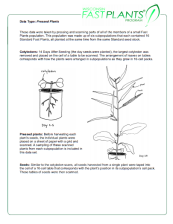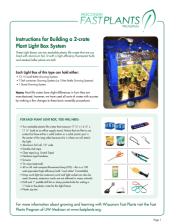Browse Resources
(1 classification) (2 resources)
Fast Plants (Brassica rapa) Research Resources
| Research projects
(1)
|
Resources | |
|---|---|
These data sets were meticulously collected by Dr. Paul Williams in an investigation in which we were interested in learning about how nutrient limitations effect a variety of easily observable and measureable Fast Plant traits. Observations were made and recorded at different points in the plants'...
These instructions describe how to construct a plant light box from two stackable plastic file crates that are cut, lined with aluminum foil and lit with a 40/42-watt CFL bulb. This 3-page document includes a complete materials list and 12-step assembly instructions with photographs that illustrate...
| |

